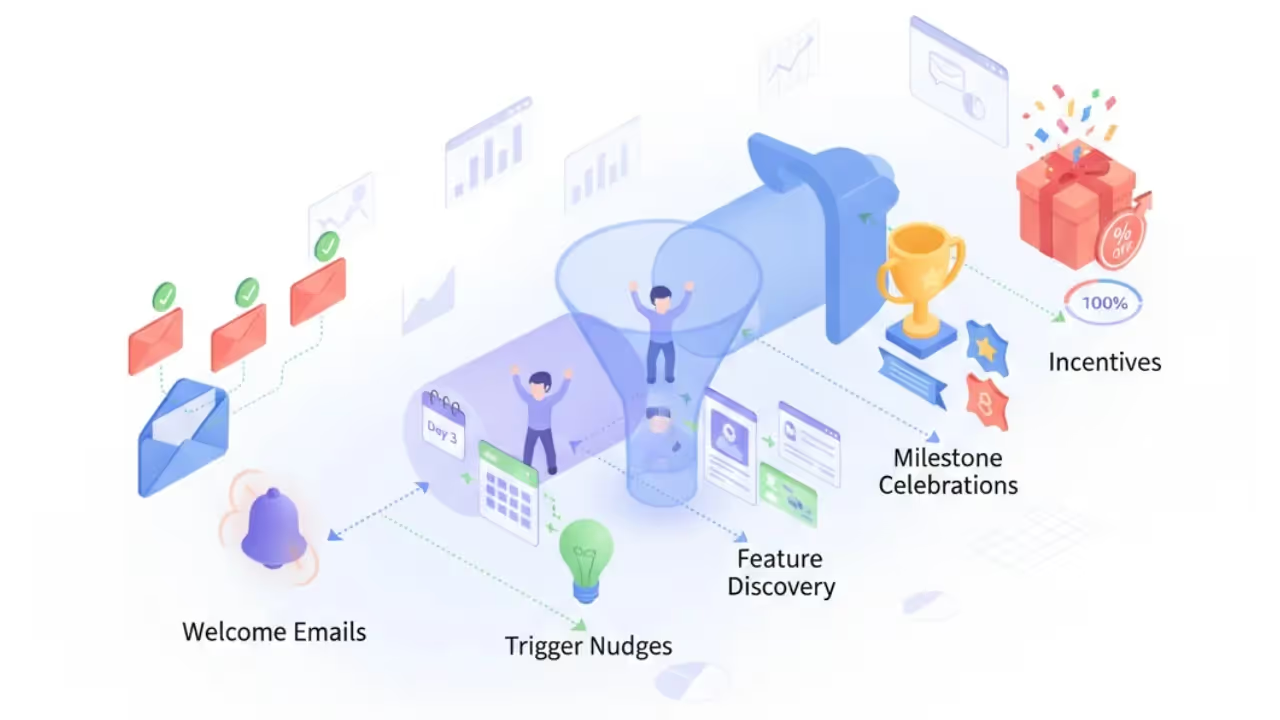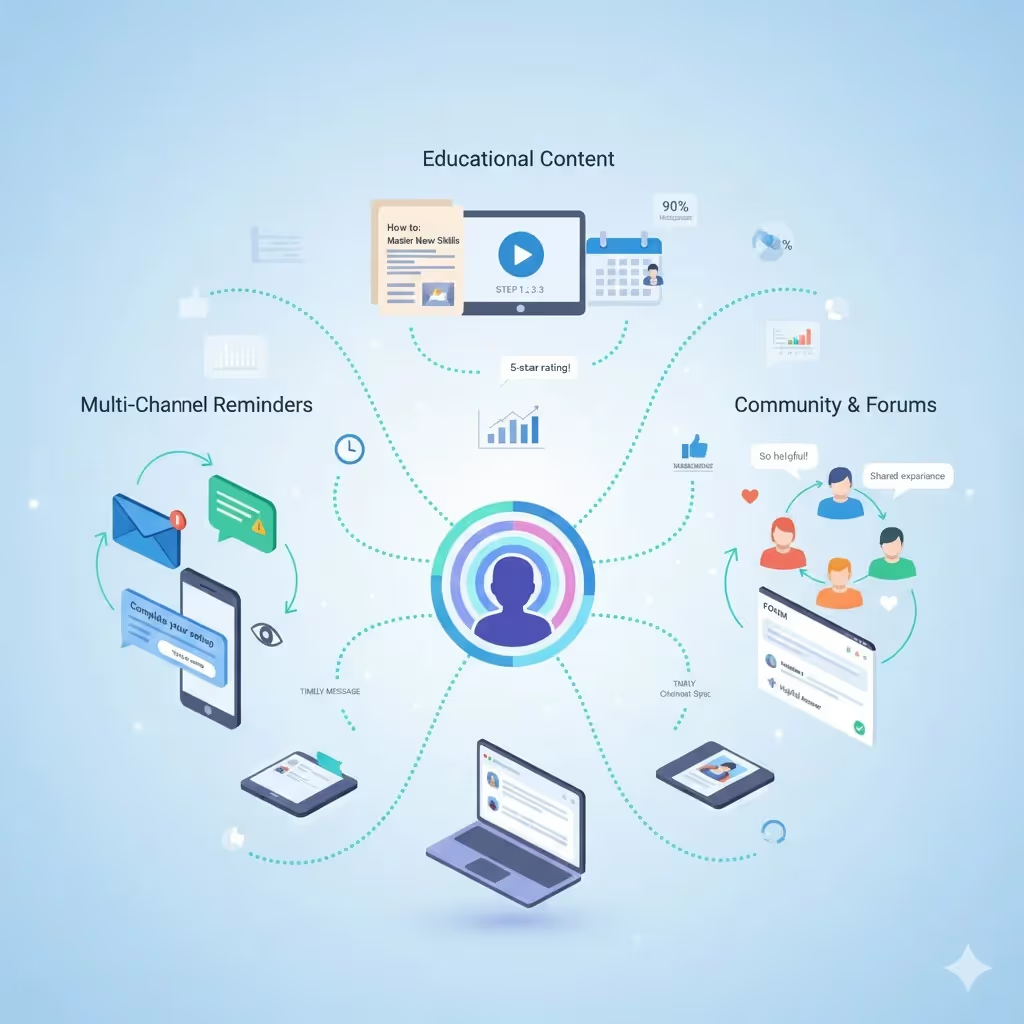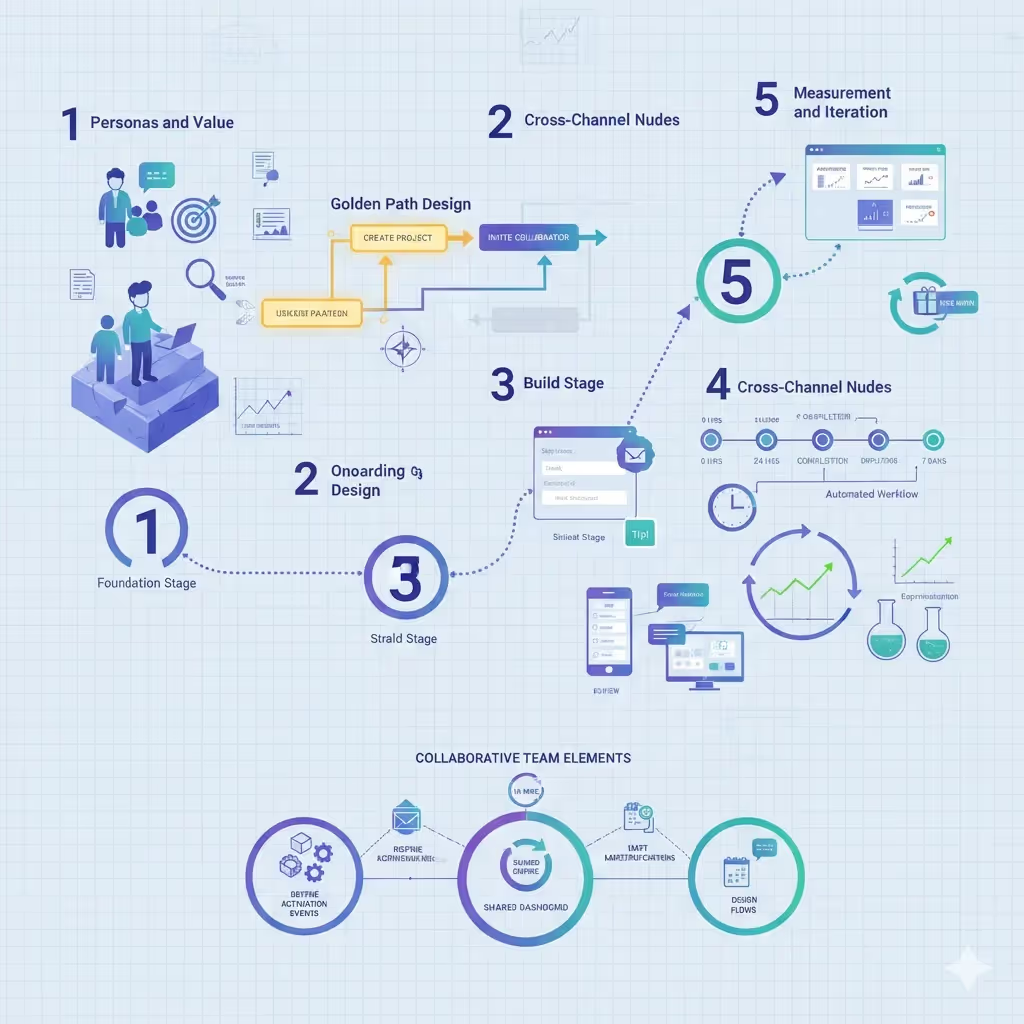What Is Customer Activation? Guide (2025)
Discover the concept of customer activation, steps to activate users, and how activation drives product adoption and retention.

Early-stage founders and product leaders often nail sign‑ups yet struggle with usage. Attracting people to a service is only half the battle. The real difference between flash‑in‑the‑pan growth and sustainable success lies in what happens after the first click.
This guide tackles the deceptively simple question – what is customer activation – and shows how focusing on that step can transform casual visitors into loyal users. Expect clear definitions, strategic frameworks, practical tactics, and real‑world benchmarks to help you make activation a core part of your product strategy.
What is customer activation?
Customer activation is the moment when someone first experiences real value from your product and begins meaningful engagement. Contentsquare defines it as “guiding your customers through every stage of their path … so they actively engage, and motivating them to use your product regularly”. Mailchimp explains that a user activation rate measures when people complete a critical action that signals they’ve experienced the product’s core valuemailchimp.com. In our view, customer activation is the process of guiding them to that “aha moment”mailchimp.com. In other words, activation marks the transition from passive curiosity to active usage.
Put simply, if you still wonder what is customer activation, it’s the point when users realise your product’s promise and take an action that delivers value.
Many related terms sound similar but play different roles:
- User onboarding vs. activation – Onboarding introduces features and teaches people how to find their way around the interface. Activation is the point where they apply what they’ve learned and see results. Tutorials alone don’t guarantee success; Nielsen Norman Group warns that long tutorials often interrupt users and are quickly forgottennngroup.com.
- Activation vs. conversion – A conversion could be a sign‑up or first purchase. Activation is more than a transaction because it ensures the person uses the product meaningfully. For a to‑do app, a sign‑up is conversion; creating the first task is activation.
- Activation vs. retention vs. advocacy – Retention measures whether people keep coming back. Advocacy measures whether they promote your product. Activation is the bridge between acquisition and those later stagesmailchimp.com.
- Brand activation – Mailchimp writes that brand activation refers to strategies that bring your brand’s promise to life through memorable experiencesmailchimp.com. It relates to marketing rather than product usage, so address it separately.
Activation deserves distinct attention. Without it, you may acquire many leads who never realise value and quickly leave. Focusing on this stage ensures that acquisition spend translates into engaged users and sets the foundation for retention and growth.
Where activation fits in the customer path and why it’s a pivot
A typical user path flows from awareness and sign‑up, through activation, into retention and, eventually, advocacy. Activation sits between sign‑up and retention, acting as the turning point that determines whether someone sticks around or drifts away. Mailchimp’s guide stresses that activation “transforms curious newcomers into engaged users”mailchimp.com. Contentsquare shows that businesses often find customers who pay but rarely use the product; activation helps re-engage them and ensures new users start on the right foot.

When activation is weak, growth leaks: you pour resources into acquiring people, but most drop off before becoming long‑term users. Strong activation locks in those who grasp the value early on, creating a base for retention and word of mouth. A funnel visual can help illustrate this flow: the top narrows to the activation stage, then widens again as engaged users spread the word.
Activation metrics and KPIs: how to measure success
To quantify what is customer activation for your product, start by defining the action that truly delivers value.
Choosing the right activation event
The first step in measuring activation is defining what action counts as activation for your product. It must correlate with long‑term retention. Contentsquare’s guide offers examples:
- First core feature use – such as creating a first project in a productivity app or launching an email campaign in a marketing tool.
- First purchase or repeat purchase – for ecommerce sites, activation might be the first completed checkout or a second purchase.
- First value milestone – for an SEO tool, generating a keyword report may mark activation.
Avoid trivial events like merely logging in; they rarely predict retention. Periodically revisit your activation definition as your product changes.
Core metrics to track
- Activation rate – The proportion of new users who reach the activation event. Mailchimp explains that it is calculated as (number of users who reached activation ÷ number of sign‑ups) × 100. Userpilot reports that activation rates vary widely: artificial intelligence and machine learning tools average 54.8%, CRM & sales tools 42.6%, MarTech 24%, healthcare 23.8%, HR 8.3%, and fintech & insurance 5%. These benchmarks show that complex or regulated industries often have lower activation.
- Time to activate – The time between sign‑up and the activation event. A shorter time to first value usually correlates with higher retention.
- Feature adoption rate – The share of users adopting specific features. This is useful for multi‑feature products.
- Daily/Weekly/Monthly active users (DAU/WAU/MAU) – Activity metrics indicate ongoing engagement. Gainsight reports that DAU/MAU ratio (stickiness) varies by product type; social media apps exceed 50%, ecommerce averages 9.8%, finance 10.5%, general SaaS 13%, and B2B SaaS about 40%. Improving activation and reducing time to value boosts this ratio.
- Visitor‑to‑signup rate – The percentage of visitors who sign up. It shows conversion at the top of the funnel.
- Signup‑to‑subscriber rate – For subscription models, this indicates how many trial users become paying customers.
- Drop‑off analysis – Track drop‑offs at each onboarding step to identify friction points.
- Qualitative feedback – Net Promoter Score (NPS) surveys and user interviews reveal how new users perceive the product.

Best practices in metric design
- Pick meaningful activation events. They should reflect a value‑driven action, not just a login.
- Check correlation with retention: if users who hit the activation event stay longer and spend more, the event is meaningful. Revisit it regularly as your product changes.
- Beware of vanity metrics. Metrics that make you feel good but don’t inform decisions waste time.
Activation strategy framework: building your playbook
Designing an activation strategy begins with a clear answer to what is customer activation for each persona and use case.

1. Know your ideal customer and define personas
Activation starts with understanding who you’re serving. Revisit your buyer and user personas. Identify the jobs they’re trying to accomplish and their pain points. According to Contentsquare, you should look past demographics to understand users’ needs and motivations. What does value look like for each persona? Activation for a small business owner may differ from that of an enterprise manager. Consider multiple activation events if necessary, but avoid diluting focus.
2. Map the user path and define a golden path
Use analytics to map how people move through your product. Identify paths taken by your most engaged users and compare them with those who churn. Define the minimal sequence of steps that reliably leads to activation – this is your golden path. Overlay friction points where people drop off. Session replays and heatmaps are useful here.
3. Design onboarding and activation flows
- Progressive onboarding – Break onboarding into small steps. Use guided tours, checklists, or wizards that encourage action without overwhelming people. Nielsen Norman Group warns that intrusive tutorials can interrupt peoplenngroup.com, so favour contextual help over long tutorials.
- Contextual tooltips and coach marks – Provide hints at the moment of need.
- Triggered emails and nudges – Welcome emails, reminders and “finish setup” prompts can drive people back to the product.
- In‑app messaging – Show milestones and suggest next actions.
- Incentives – Offer free credits, discounts or badges for completing activation steps. For example, many SaaS products give an extended trial after the first project is created.
4. Drive interaction outside the product
Your activation strategy doesn’t end in‑app. Use:
- Articles, webinars and tutorials to teach new use cases.
- Community forums where users share tips.
- Referral incentives tied to activation, such as giving existing users credit when their invitee completes activation.
- Loyalty or gamification programmes that reward milestones (points, badges, tiered access).
5. Continuous experimentation and optimisation
A/B test onboarding flows, messaging and UI changes to see what drives more activation. Contentsquare suggests using heatmaps and session replays to detect where users struggle. Collect feedback through surveys and interviews. Iterate your activation funnel continuously; what works today may not work tomorrow.
6. Reactivation strategies for dormant users
Activation isn’t only for new users. Identify people who signed up but never activated, or who have lapsed. Send targeted campaigns, offer personalised support, or re‑run onboarding flows. Approach reactivation as its own funnel and measure reactivation rate.
Tactics, tips and examples
The following sections make customer activation tangible by outlining practical ways to guide users toward their first success.
Customer engagement and conversion tactics
- Welcome emails or drip campaigns – Send a series of helpful emails showing important features. Mailchimp emphasises turning sign‑ups into engaged users through guiding them to core valuemailchimp.com.
- Trigger‑based nudges – If someone doesn’t finish onboarding within a few days, send a reminder with one clear next step.
- Feature discovery nudges – After completing a milestone, suggest a related feature.
- Milestone celebrations – Celebrate achievements (“You created your first project!”) to build momentum.
- Incentives – Offer discounts or free upgrades when users reach activation.

Improving user experience and removing friction
- Clear interface and calls to action – Avoid clutter. Make primary actions obvious.
- Reduce steps – Ask only for essential information during sign‑up.
- Contextual help – Provide tooltips and inline guidance rather than forcing long tutorialsnngroup.com.
- Progressive disclosure – Introduce advanced features later so new users aren’t overwhelmed.
- Quick wins – Focus on actions that deliver immediate value, like generating a first report or creating a first to‑do list.

Gamification and loyalty programmes
- Points and badges – Award points for completing important tasks. Publicly display badges to encourage repeat actions.
- Progress bars – Show progress toward activation to motivate completion.
- Tiered access – Make advanced features available after activation to create a sense of accomplishment.
- Referral bonuses – Offer rewards to users who refer others and see them reach activation.

Cross‑channel activation outside the product
- Emails, push notifications and SMS to remind users of unfinished tasks.
- Blogs, tutorials and webinars to showcase successful use cases.
- Community or user forums where people share experiences.

Real‑world examples
- SaaS tool – A project management platform defines activation as creating the first project and inviting a collaborator. Users who do so within a week have higher retention.
- Ecommerce – Activation may mean a second purchase. Many online retailers send targeted discounts to prompt the first repeat purchase.
- Mobile app – Activation might be completing the first workout in a fitness app or sharing the first post on a social network. Business of Apps reports that sports apps have the highest activation rate on day one, while finance apps have the highest by day 30businessofapps.com.
Challenges, risks and common pitfalls
- Poorly defined activation events – If your activation event is too trivial, it won’t predict retention; too restrictive, and few users will reach it.
- Events that don’t lead to retention – Activation must correlate with ongoing usage. Validate with data.
- Over‑automation and aggressive nudging – Too many emails or pop‑ups can annoy users and increase churn.
- Ignoring segmentation – Different personas may have different activation paths. One-size‑fits-all onboarding might alienate some.
- Too many features during onboarding – Overloading new users can discourage them.
- Neglecting reactivation – Dormant users represent untapped potential.
Tools and platforms that help with activation
Several tools can help deliver on what is customer activation by tracking behaviour and personalising communication.
- Product analytics and behaviour tools – Contentsquare’s experience analytics, heatmaps and session replay help teams see where users struggle.
- In‑app onboarding tools – Userpilot, Appcues and Pendo allow you to build checklists, tooltips and guided tours without heavy development.
- Email automation platforms – Mailchimp, Customer.io and SendGrid can trigger onboarding sequences and reminders.
- A/B testing tools – Optimizely or VWO enable experiments on onboarding flows.
- Customer feedback tools – Typeform and SurveyMonkey help collect qualitative data; NPS tools gauge satisfaction.
- Data platforms / CDPs – Segment or RudderStack connect behavioural data with marketing channels.
Putting it all together: a sample activation roadmap
Below is a simplified activation plan for a hypothetical early‑stage SaaS product. This example shows what is customer activation in a step‑by‑step plan.
- Personas and value – Clarify primary personas (e.g., solo founders vs. small teams). Identify what success looks like for each. Use surveys and interviews to understand needs.
- Golden path design – Analyse behaviour data to find the shortest sequence of actions that deliver value. Suppose the critical path is creating a first project, adding a task and inviting a collaborator.
- Onboarding design – Build a signup flow that asks only for an email and password. Immediately prompt the user to create a project. Use a checklist with three tasks: create project, add task, invite collaborator. Provide tooltips and a guided walkthrough.
- Cross‑channel nudges – Send a welcome email with the first step. If the user doesn’t complete the first task within 24 hours, send a reminder with a link directly to the project creation screen. After completion, send a congratulations message and suggest inviting a collaborator. Offer a free month of premium features if they invite someone within seven days.
- Measurement and iteration – Track activation rate, time to activate, drop‑offs at each onboarding step, and feedback scores. Conduct monthly reviews to test new experiments. Use A/B tests on messaging or UI to see what increases activation. suggests checking metrics regularly but allowing time for changes to take effect.

In this plan, product, marketing and UX teams work together. Product defines the activation event and builds features; marketing crafts emails; UX designs flows and collects feedback. A shared dashboard keeps everyone in sync.
Conclusion
Activation is the hinge between acquisition and retention. It’s not enough to attract sign‑ups; you need to help people experience value quickly. Defining clear activation events, measuring the right metrics, and building thoughtful onboarding flows will pay off in higher retention, increased revenue and stronger advocacy. According to Userpilot’s benchmarks, activation rates can vary from over 50% in artificial intelligence tools to under 10% in HR and fintech, showing the scale of the challenge. The payoff is worth it: Fairmarkit observed that a 25% increase in activation correlates with a 34% rise in revenueproductfruits.com.
Focusing on what is customer activation turns sign‑ups into lasting relationships and fuels growth.
To start, pick one activation event that reflects genuine value, instrument it, and design a simple onboarding flow to guide users there. Measure results, collect feedback and iterate. Approach activation as an ongoing discipline rather than a one‑off project. Focus on user value, and growth will follow.
FAQ
1) What is the meaning of activation?
Activation refers to the moment when a new user first derives real value from your product. It’s the point where they move from passive signup to active usage, such as launching their first email campaign or completing a first workout. Activation differs from a basic conversion because it signals that the user has crossed the threshold into meaningful engagement.
2) What is an example of user activation?
Examples vary by product. For a productivity app, activation might be creating the first project. For an ecommerce site, it could be completing a checkout or making a second purchase. For a social media platform, activation may mean posting the first piece of content or following a certain number of accountsmailchimp.com.
3) What does service activation mean?
Service activation usually refers to turning on a product or feature so it’s ready for use. In a SaaS context, it often coincides with the moment when a user sets up the service and uses a core feature. For example, integrating a first data source into an analytics tool marks the activation of that servicemailchimp.com.
4) What is the meaning of account activation?
Account activation typically means verifying a user’s identity and enabling their account after registration. It may involve clicking an email verification link or entering a code. Account activation should not be confused with customer activation; verifying an account doesn’t guarantee the user has realised value. A robust activation strategy goes further to guide users to that first meaningful success.








.avif)




